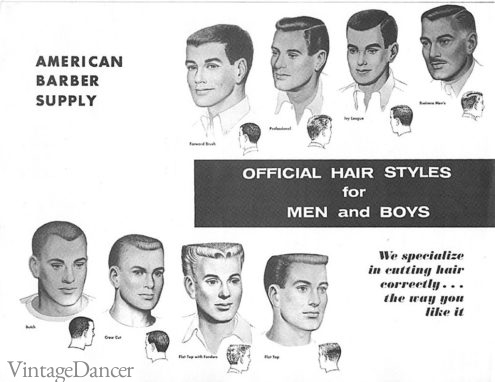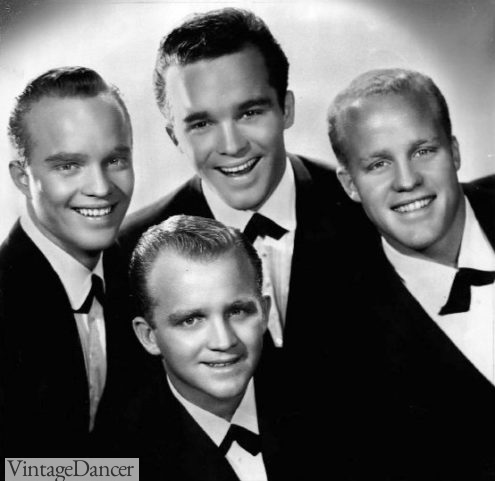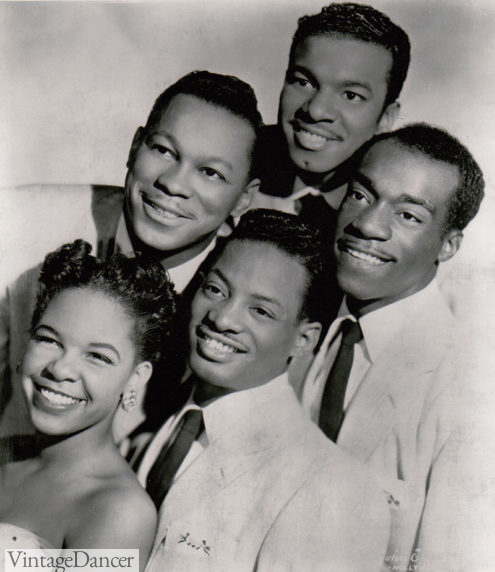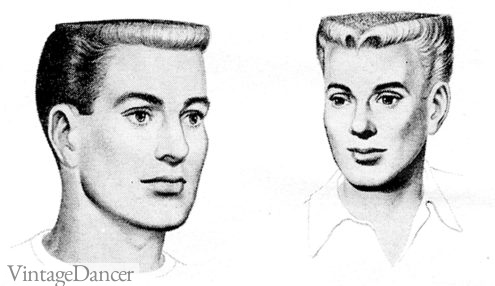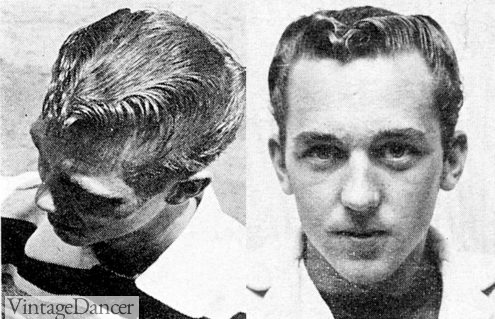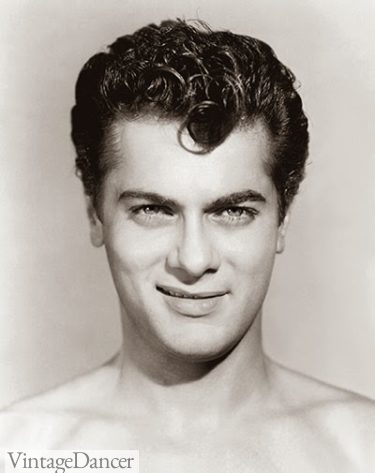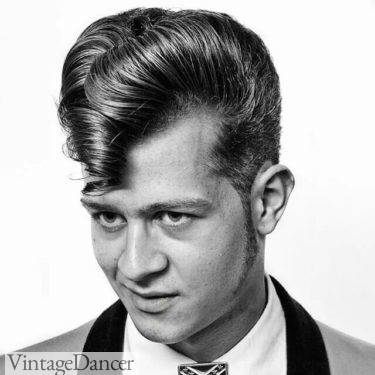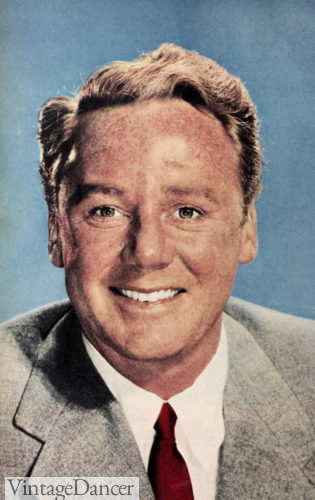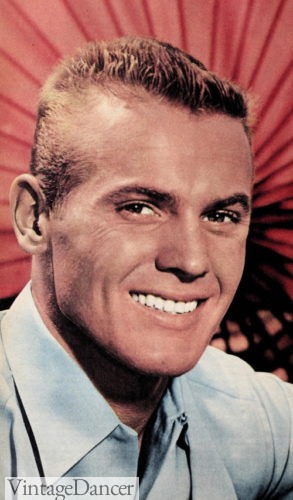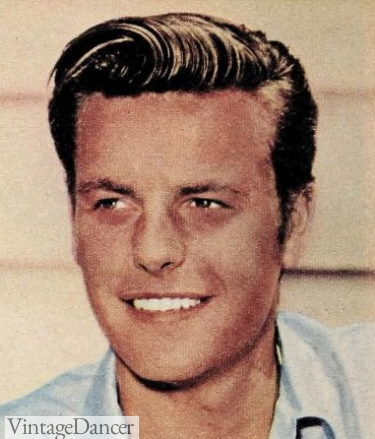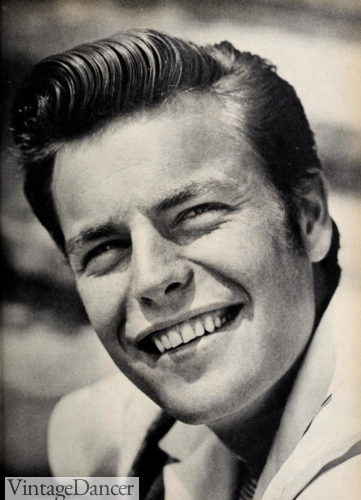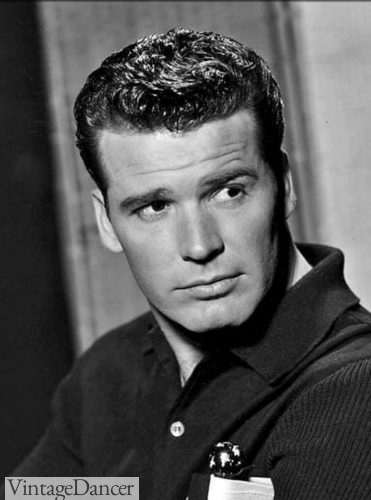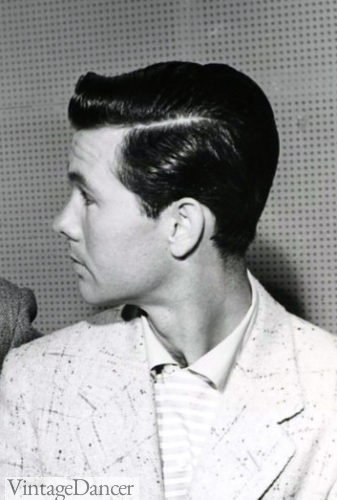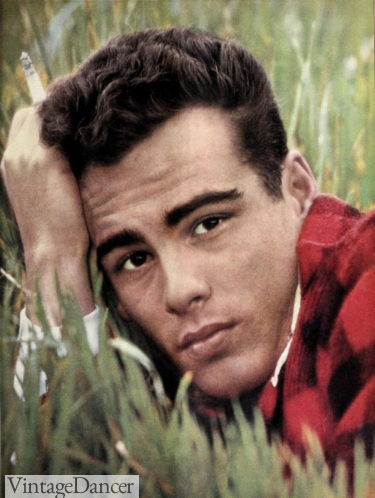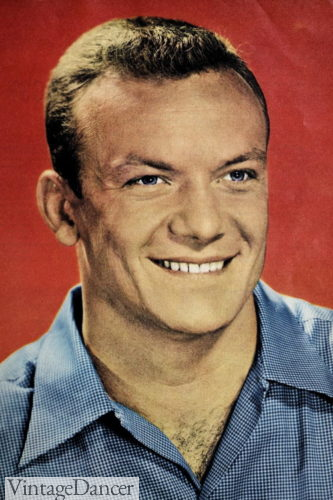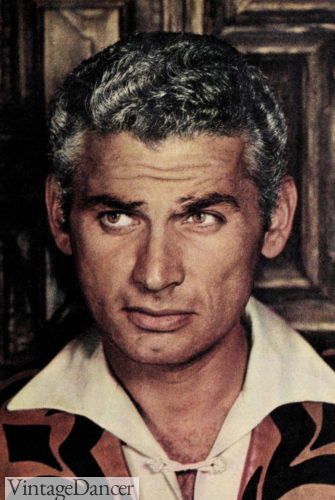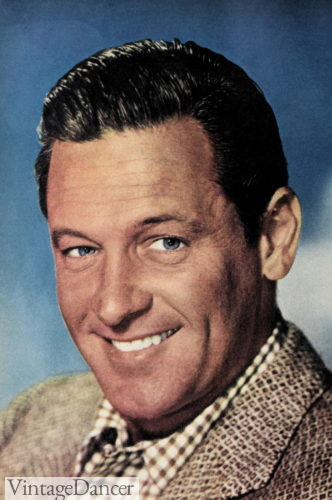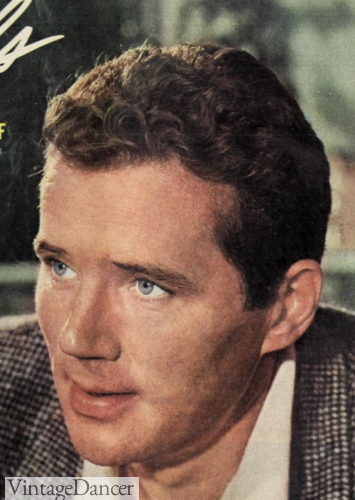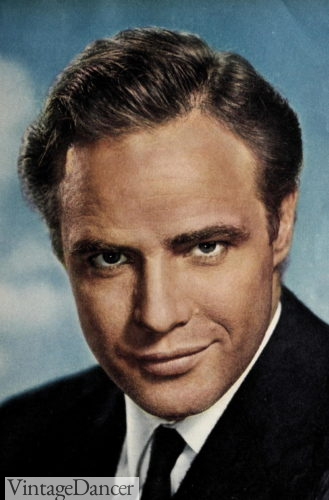By the 1950s, some of the more trendsetting men’s barbers were calling themselves hairstylists. This owed to the fact that 1950s men’s hairstyles were exploding in variety, popularity, and visibility of offerings. ’50s men could get their hair dyed, permanently waved (permed), or even purchase a new head of hair entirely.
Wigs (toupees), and public admission of wearing said wigs, were popular in the ’50s among both celebrities and civilians alike. Men’s haircuts of the ’50s had incredible variety in length and style compared to previous years. From the crew cut to the dyed Presley pompadour, there were a lot of options for 1950s haircuts for men.
1950s Men’s Hair Styles
The general trend for men’s hair in the 1950s was a short side-part with a wave. Even if his hair was not any particular style, it typically followed that standard. Wavy or slightly curly hair were popular in the decade, leading to the appeal of both perms and toupees. Hair could be matte or shiny, and if present, bangs were soft. While standard barbers stuck to the basics, an avant-garde hairstylist could dye, texture, and overhaul a man’s hair. These changes were always subtle and natural-looking — no extreme highlights or bright colors.
A good businessman kept himself well groomed without a hair out of place. 1950s men’s hair products, like pomades and sprays (especially the Brylcreem brand), were regularly used by many men to maintain their hairstyles. Scruffiness would also grow popular in the middle-end of the decade, allowing hairstyles to become messier and reintroducing the beard into pop culture after 50+ years without it. Worn mostly among beatniks, beards were generally only accepted in the late 1950s in more progressive urban areas such as New York City and San Francisco. Sideburns were acceptable if maintained and tasteful.
Crew Cut
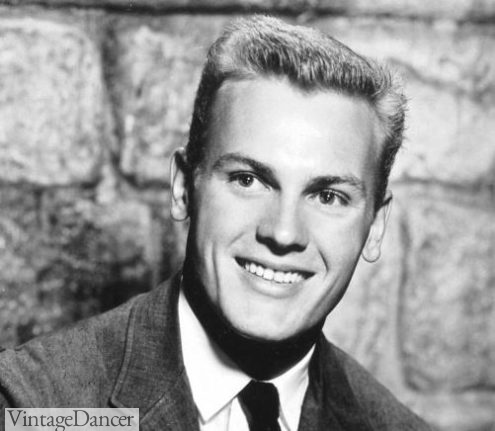
Tab Hunter with a Crew Cut
A crew cut is defined as having the top of the hair cut short, and the sides/back tapered shorter in any way that best complemented the face shape. It was slightly longer than the GI crew cut of the 1940s, but still quite short. As one of the most popular hairstyles of the decade, the 1950s crew cut had many variations and styling methods that developed into their own iconic hairstyles.
- The Ivy League haircut is a variation of the crew cut, following the same general shape but leaving hair at the front of the top of the head long enough to be styled. Using hair wax/hair product, the hair would be given a side part and groomed upwards or to the side, occasionally with a wave. It was popular among college students, businessmen, and intellectual types.
- Quiffs and Short Pompadours were similar to the Ivy League haircut in that they were longest at the front part of the top of the head. This time, however, the bangs were styled upwards, curled back (in the case of a short pompadour), and held in place with hairspray. The bouffant part of the hair could be small or very pronounced, but the longer it was, the bigger risk the man was taking. “Longhairs” were still frowned upon in the 1950s.
- Variations of the Crew Cut and Ivy League, 1959
- Ivy League and Crew Cut Variations seen on The Platters
Flat Top
Flat tops were “cool.” Matter of fact, they were among the most popular haircuts of the 1950s. Its defining feature is in the name – the hair is cut flat at the top of the head. Like most popular 1950s men’s haircuts, it required styling and hair product to maintain its shape.
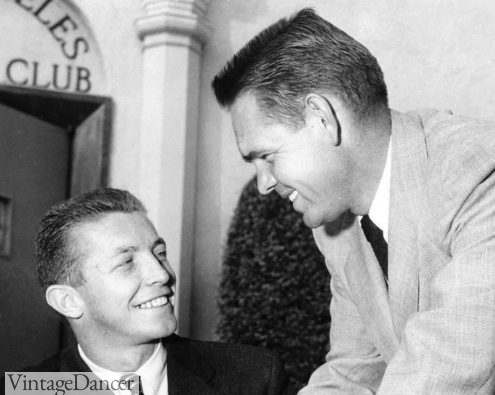
1955 Regular Cut (L) and Flat Top (R)
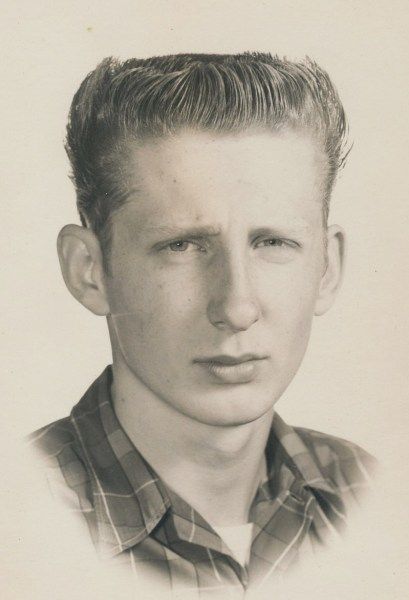
A Flat Top Boogie with “Fenders” (long hair at the sides gelled back along the head)
Most flat tops were short up top and even shorter on the sides. However, it was not uncommon to leave the sides long enough to be gelled backwards. This would become a more popular cut in the 1960s.
Butch Cut
The butch cut, or brush cut, is another very short haircut. Unlike the crew cut, it lacks any taper or graduation and is the same size in every dimension or only slightly longer on top. Today this hairstyle is most often called a buzz cut. Unlike most 1950s haircuts, this one required minimal styling and maintenance. It was most popular among sporty teenagers and those of military career/backgrounds, likely for that same reason.
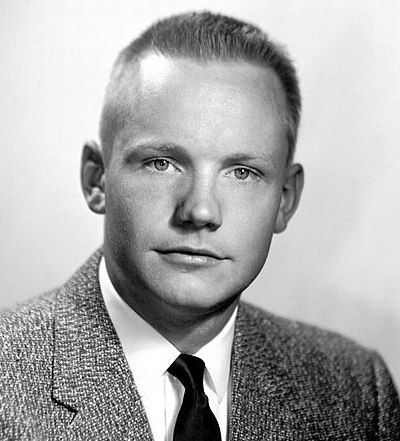
Neil Armstrong, Age 26 (1956) – Butch or Very Short Crew Cut
Conked Hair
Since the 1920s, the conk had been the primary hairstyle for African American men. It involved using lye to chemically straighten the hair, then styling it in line with the conventional 1950s part and wave.
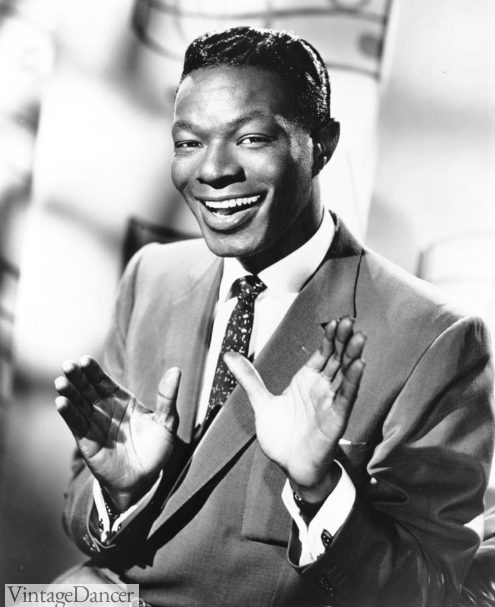
Nat King Cole with a Standard Conk
In the ’50s however, men’s conked hair was also getting longer and more complicated. For those looking to show off, this longer conk could be styled up into a tall pompadour, as seen on performers like Chuck Berry and Little Richard. Big hair meant big money and a lot of time to keep it maintained, making these longer hairstyles something of a status symbol among performing men.
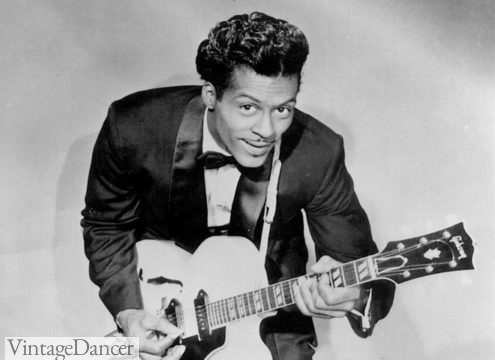
Chuck Berry with a Big New Conk
Early Afro
Conks were not the only hairstyle available to 1950s black men. Hair was also kept natural in the form of a short, neat afro. Free from the pain and expense of maintaining hair with harsh chemicals, it became more popular as the decade progressed. This short afro was seen on a variety of men, ranging from performers, to musicians, to public speakers. Like every other 1950s hairstyle, it would see an increase in length as the 1960s approached.
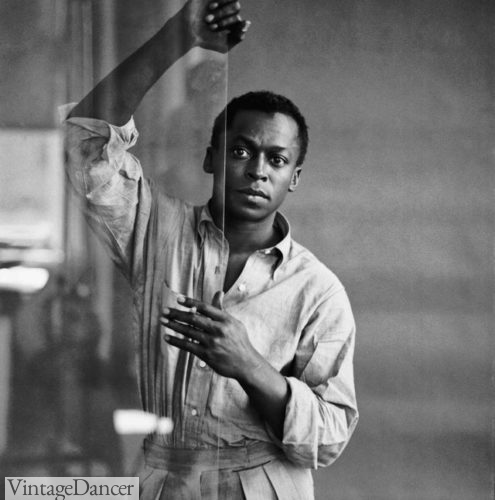
Miles Davis with a Standard 1950s Short Afro in the Late 1950s
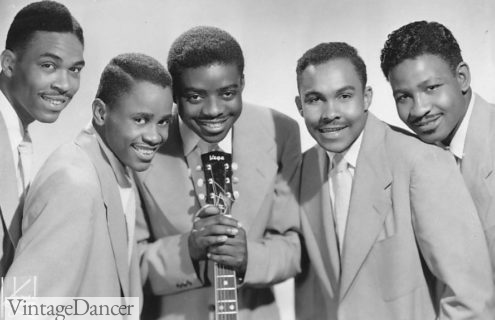
Members of The Clovers in Various Natural Hairstyles and Lengths (1951)
1950s afros were kept short and neatly groomed, generally shorter on the sides than up top. His hair could also be cut to resemble other hair silhouettes, such as a Flat Top or pompadour. Some men would even shave a line into their hair to resemble a side-part, as seen above. For those looking for shine or a wavier texture, hair could be brushed with oil.
The more rounded “retro” afro would emerge in the 1960s.
Caesar Cut
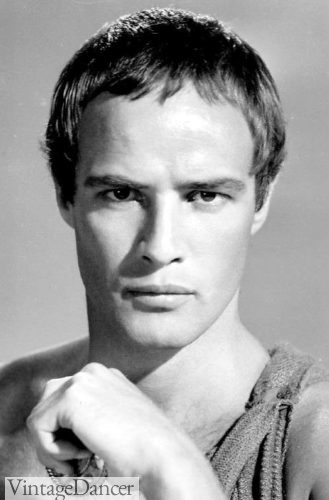
Most famously seen on Marlon Brando in Julius Caesar (1953), the Caesar cut is a short hairstyle with very short, level bangs across the forehead. It was most commonly seen in rural areas on both men and boys. This hairstyle works best with thick, straight hair.
1950s Breaker Hairstyle
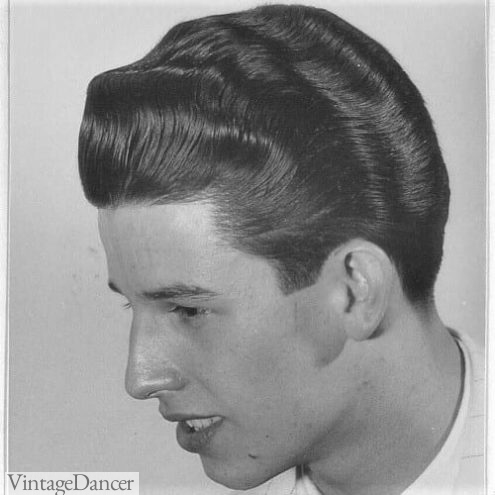
The breaker haircut used lots of styling and product to create sleek waves. Similar to the pompadour, it required longer hair at the top of the head, and took some time to get right. It was especially popular on the West Coast and among Hollywood figures where it was renamed the Hollywood cut.
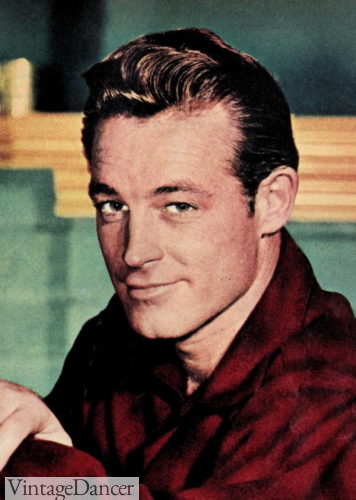
1955 Guy Madison
1950s Greaser Hairstyles
Greasers were predominately young men of working-class backgrounds. Ergo, many wore simple working-class men’s haircuts: butch cuts, flat tops, Caesar cuts, and short afros for heavily textured hair. However, there were also more unique longer hairstyles seen in rebellious greaser circles. These were not normal, socially acceptable haircuts you saw on professional men. Rather, they were uncommon styles reserved for actors and rebels.
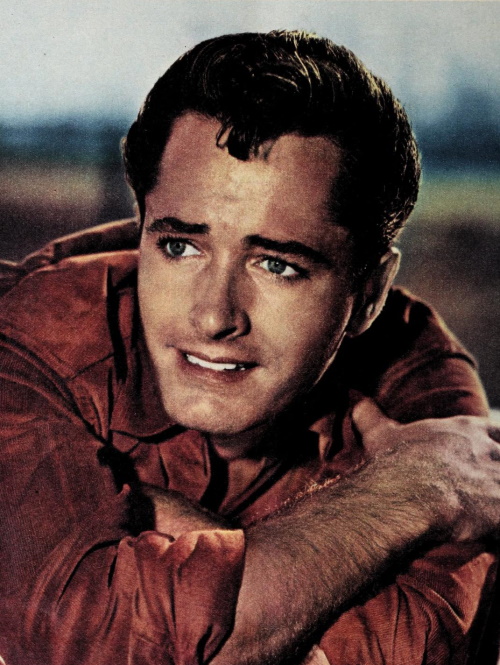
1955 John Derek
1950s greaser haircuts could be entirely new cuts, or simply unique style variations on standard cuts. Unlike standard 1950s norms, many greasers also kept their hair very slick and shiny.
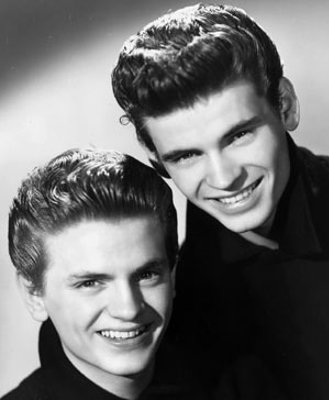
The Everly Brothers
Long Pompadour
Pompadours and Quiffs could both be as long as the wearer desired, provided they were kept in shape. While businessmen were limited to short pompadours, young men and performers could express themselves with big, bouffant hair. These long pompadours were often feathered to take weight off and add texture, especially in the later half of the ’50s. They could be shiny or matte.
Both James Dean and Elvis Presley, 1950s icons, wore long wild pompadours that ended up defining the decade.
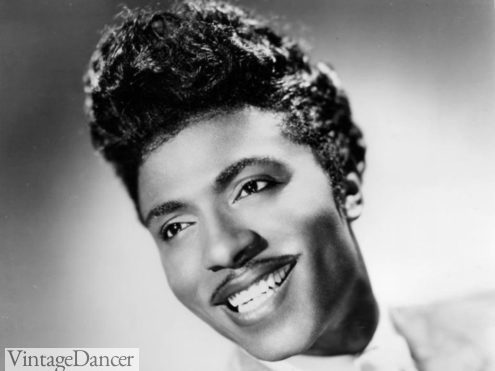
Little Richard with a Bouffant Pompadour
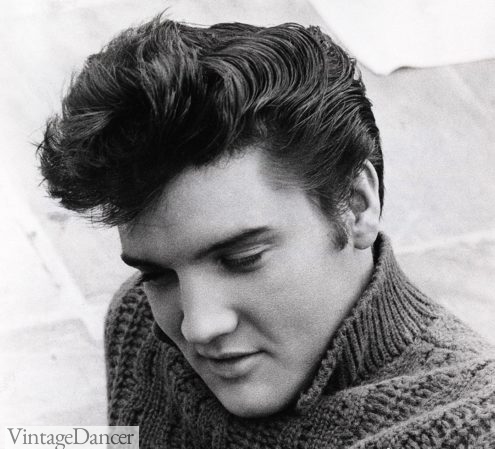
Elvis Presley in 1957 with a Soft Pompadour
Boogie Hair Style
The boogie was not a haircut per se, but rather a method of styling. Virtually any haircut could be given a boogie treatment, provided the hair could be combed forwards and inwards to create the “boogie” shape.
- Flat Top (L) and Flat Top Boogie (R)
- Boogie Haircut
The Flat Top (flat top boogie!) and other short styles were preferred. More dramatic versions of the Boogie would end up evolving into the Jelly Roll hairstyle.
Jelly Roll
Named after the shape the hair ends up taking on, the Jelly Roll hairstyle was dramatic, style-heavy, and unique. Longer hair was combed upwards and inwards to create a symmetrical rolling crest that looked like its namesake — a jelly roll. British Teddy Boys (Teds) seemed to prefer this hairstyle.
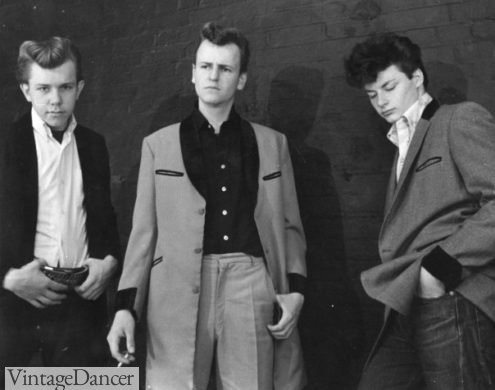
A Group of Teddy Boys – Jelly Rolls on the Left Two
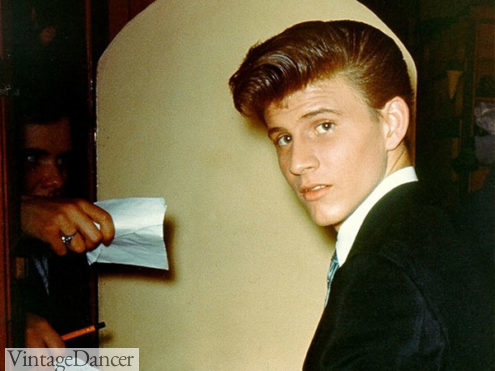
Bobby Rydell Sporting a Jelly Roll (1959)
The jelly roll is very often misidentified as a pompadour. There is also a lot of debate as to what separates a jelly roll from a pompadour. I say that there are many fusions of the two hairstyles, but as a general rule, hair with a jelly roll goes down or out from the forehead, while the pompadour goes (relatively) straight up or slightly back.
Elephant Trunk
The elephant trunk was more of an accent than a hairstyle in and of itself. From a long pompadour or (most likely) jelly roll, a man could tease some of his hair to come down over the forehead, into his face, in a shape similar to an elephant trunk.
- Tony Curtis with a Small 1950s Elephant Trunk
- Dramatic Elephant Trunk with D.A. and Sideburns
For as prevalent as it was said to be, it’s very hard to find original 1950s elephant trunk photos.
D.A.
Ducktail, duck’s ass, duck’s arse, or simply D.A. — this was a hairstyle of many names. Similar to the boogie, it was a styling method rather than a cut in and of itself. It was also a style of many uses, since it only covered the back of the head.
In the 1950s D.A. hairstyle, hair was parted down the middle and pomaded down across the sides. It was a unisex style, worn by both men and women. For men, it was often paired with a messy top, pompadour, elephant trunk, or jelly roll at the front.
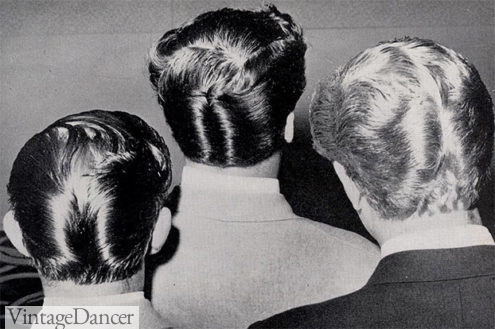
Examples of DA Hairstyles
Read More
- 1955 Guy Madison
- 1955 Van Johnson
- 1955 Tab Hunter
- 1955 Robert Wagner
- 1955 Bob Wagner
- Johnny Carson, 1955
- 1958 Dean Stockwell
- 1955 Aldo Ray
- 1955 Jeff Chandler
- 1955 Bill Holden
- 1955 Marlon Brando
